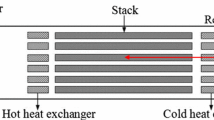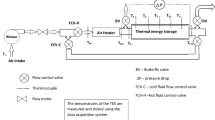Abstract
The aim of this paper is to perform the experiment and the numerical simulation for investigating the heat transfer in a regenerator system with ceramic honeycomb and to suggest a useful correlation for optimization of the regenerator system. For achieving this, the effects of some parameters were investigated, e. g., switching time, cell size and length of honeycomb on the mean temperature efficiency. The measured temperatures by R-type thermocouples were compared with the predictions by means of the commercial package, STAR-CD. A useful correlation for thermal efficiency was newly proposed as a function of the normalized switching time, defined in terms of switching time, cell size and length of honeycomb. The results showed that the thermal efficiency is above 90% and the normalized heat exchange rate is higher than 80% when the normalized switching time is less than 1000.
Similar content being viewed by others
Abbreviations
- A cell :
-
Cross-sectional area of cell, of honeycomb
- L r :
-
Honeycomb length
- n cell :
-
The number of cell per unit area.
- Q cell :
-
Volume flow rate of exhausted gas per unit cell
- Q t :
-
Total volume rate of exhausted gas
- q * :
-
Normalized heat exchange rate
- T :
-
Temperature
- T eff :
-
The mean temperature efficiency
- t pass :
-
Flow passage time
- t * :
-
Normalized switching time
- t f :
-
Switching time
- η:
-
Efficiency
- in:
-
Inlet region
- out:
-
Outlet region
- h:
-
Heating process
- c:
-
Regenerating process
References
Akter, S. and Hossain, I., 1997, “Waste Heat Utilization in a Ceramic Industry,”International Journal of Energy Research, Vol. 21, pp. 1215–1221.
ICEM-CFD Manual. 1998.
Kaviani, M., 1995. “Principles of Heat Transfer in Porous Media,” Second Edition, Springer-Verlag NY.
Kluka, J. A. and Wilson, D. G., 1998, “Low-Leakage Modular-Regenerators for Gas-Turbine Engines,”Journal of Engineering for Gas Turbines and Power, Vol. 120, pp. 358–362.
Monte, F. de, 1999, “Cyclic Steady Thermal Response of Rapidly Switched Fixed-Bed Heat Regenerators in Counter-Flow,”International Journal of Heat and Mass Transfer, Vol. 42, pp. 2591–2604.
Muralikrishna, S., 1999, “Study of Heat Transfer Process in a Regenerator,”Trans IchemE. 77 (part A), pp. 131–137.
Saastamoinen J. J., 1999, “Heat Transfer in Cross-Flow Regenerators,”International Journal of Heat and Mass Transfer, Vol. 42, pp. 3205–3216.
STAR-CD Manual. 1998
Suzukawa, Y., Sugivama, S., Hino, Y., Ishioka, M. and Mori, I., 1997, “Heat Transfer Improvement and NOx Reduction by Highly Preheated Air Combustion,”Energy Convers. Mgmt. Vol. 38, pp. 1061–1071.
Willmott, A. J., 1993, “The Development of Thermal Regenerator Theory from 1931 to the Present,”Journal of the Institute of Energy, Vol. 66, pp. 54–70.
Author information
Authors and Affiliations
Rights and permissions
About this article
Cite this article
Noh, D.S., Hong, S.K., Ryou, H.S. et al. An experimental and numerical study on thermal performance of a regenerator system with ceramic honeycomb. KSME International Journal 15, 357–365 (2001). https://doi.org/10.1007/BF03185219
Received:
Revised:
Issue Date:
DOI: https://doi.org/10.1007/BF03185219




